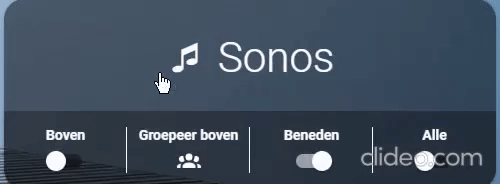@LarsNiet wrote:
I saw this amazing plugin called card-mod which gives you the ability to style (almost) any element within the Home Assistant frontend. Since I am a frontend dev, I just love making everything as pretty and interactive as I can.
The problem with card-mod is that it’s quite limiting. If I really wanted to make my dashboard look like some insane Van Gogh, my ‘ui-lovelace.yaml’ file would be 50.000+ lines long. The problem here is that all styling has to be done inside this file.
Let me give an example to demonstrate this. I just wanted a simple animation for a icon in my custom banner-card. This looks like:
Even though this isn’t some crazy animation it takes up a lot of space in my lovelace files. For this simple animation I need these lines of code:
- type: custom:banner-card background: "rgba(0, 0, 0,0.5)" heading: "\U0001F39C Sonos" row_size: 4 style: | h2 { margin: 28px; } .overlay-strip { border-radius: 0 0 20px 20px; } @-webkit-keyframes ha-icon { 16.65% { -webkit-transform: translateX(8px); transform: translateX(8px); } 33.3% { -webkit-transform: translateX(-6px); transform: translateX(-6px); } 49.95% { -webkit-transform: translateX(4px); transform: translateX(4px); } 66.6% { -webkit-transform: translateX(-2px); transform: translateX(-2px); } 83.25% { -webkit-transform: translateX(1px); transform: translateX(1px); } 100% { -webkit-transform: translateX(0); transform: translateX(0); } } @keyframes ha-icon { 16.65% { -webkit-transform: translateX(8px); transform: translateX(8px); } 33.3% { -webkit-transform: translateX(-6px); transform: translateX(-6px); } 49.95% { -webkit-transform: translateX(4px); transform: translateX(4px); } 66.6% { -webkit-transform: translateX(-2px); transform: translateX(-2px); } 83.25% { -webkit-transform: translateX(1px); transform: translateX(1px); } 100% { -webkit-transform: translateX(0); transform: translateX(0); } } ha-icon { display: inline-block; vertical-align: middle; -webkit-transform: perspective(1px) translateZ(0); transform: perspective(1px) translateZ(0); box-shadow: 0 0 1px rgba(0, 0, 0, 0); } ha-icon:hover, ha-icon:focus, ha-icon:active { -webkit-animation-name: ha-icon; animation-name: ha-icon; -webkit-animation-duration: 1s; animation-duration: 1s; -webkit-animation-timing-function: ease-in-out; animation-timing-function: ease-in-out; -webkit-animation-iteration-count: 1; animation-iteration-count: 1; }So, back to my question. Is there any way for me to split my lovelace file up in multiple pieces? I know it’s possible to do something like “style: !include mystyle.yaml” but this did not seem to work.
Any geniuses out here that can help me out?
edit:
After some more testing, just using “style: !include mystyle.yaml” does work. However, if I wanted to use this as a class for multiple elements, this is going to be a pain… Let’s say I wanted to change the margin on my H2 styling for a specific element, I would have to create another file for that. So this is a temporary fix but not what I was looking for.For people that are interested in how I temporarily “fixed” it. I just changed style to:
style: !include "./css/wobble.yaml"In the wobble.yaml file I simply copy pasted everything including the “|”.
Posts: 2
Participants: 2
